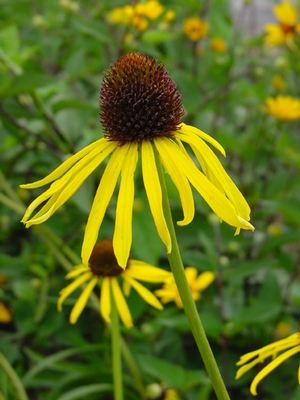Echinacea paradoxa
Common: yellow coneflowerEchinacea paradoxa LP50 - 50 per flat
- Height: 2'-3'
- Spread: 12"-18"
- Spacing: 12"
- Hardiness Zone(s): 5-9


Echinacea paradoxa LP50 - 50 per flat
A Yellow Purple Coneflower... thus the paradox. Relatively rare in the wild and in cultivation, this coneflower is stunning in summer. Its bright, pure yellow flowers consist of drooping petals surrounding a soft brown cone. Goldfinches devour the seeds. Native to the Ozark Mountains and surrounding areas.
Grow in full sun and well drained soil.
A yellow purple coneflower... thus the paradox. Relatively rare in the wild and in cultivation, this coneflower is stunning in summer. Its bright, pure yellow flowers consist of drooping petals surrounding a soft brown cone, shooting up to 3’ high. The naked single stem is punctuated with a single, strong golden-ray flower, an excellent design choice for colorful, airy movement without the bulk of leafy stems to detract from the statement. Basal leaves are long and narrow and while some patience is required, you’ll be rewarded in a few growing seasons as it reaches it’s full size and splendor. Ozark coneflower blooms through late May to July, thriving in the sunny garden. It is the most scented of all the coneflowers.
Native to the Ozark Mountains and surrounding areas, Echinacea paradoxa can be found in the prairies, glades, and limestone slopes with alkaline, freely draining soils. Ozark coneflower grows best in full sun and well-drained soil and can have winter dieback if the soil has too much clay. It grows a deep taproot, allowing it to survive drought and fire. Over the years, the basal clump will grow but do not divide it as the roots resent disturbance. Instead, allow the plant to self-sow.
Echinacea paradoxa is a delicious food source for Goldfinch and other small songbirds and you’ll see them darting and landing on the flowers when the heads set seed. Pollinators love the flowers while deer don’t like the foliage making this a perfect garden plant. The yellow flower of E. paradoxa makes this plant a favorite parent plant for hybridizers wishing to increase the color choices of Echinacea cultivars on the market.